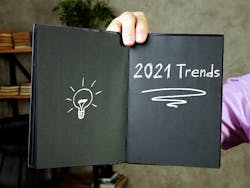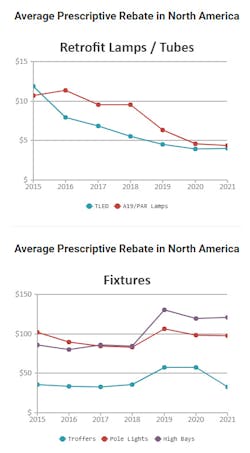The Biggest Rebate Trends for 2021
Last year was an incredibly tough year for many industries, except for maybe hand sanitizer and toilet paper. Commercial lighting was no different in 2020. As electrical utilities struggled to hit their energy savings goals, a record number programs — 20% of the active programs in 2020 — offered a bonus. Just as we have seen in previous times of economic turmoil like the financial crisis of 2008, rebates increased to spur participation. Because of this, 2021 is shaping up to be a solid year for commercial lighting rebates.
Seventy-four percent of the United States offers a commercial lighting rebate. As the adoption of LED lighting increases, we constantly get the question of if rebate programs are going to continue. In some form or another, lighting rebates have been around since the 1980s and will likely continue for the future. Even with the increased prevalence of LED technology, tons of older lighting technologies, like T-12s and metal-halide, are still being used in the United States. Therefore, lighting rebates are still going strong in 2021.
Currently, 74% of the United States is covered by an active commercial lighting rebate program. This percentage is lower than we usually see at the beginning of the year, which is typically 76% to 78%. But it still means most businesses in the country have a rebate available to them. The most significant change in 2021 is in Ohio, where the major utilities discontinued their lighting rebate programs at the end of 2020.
Rebate amounts for LEDs stay flat — and that’s remarkable. For the first time in years, the average prescriptive rebate for LED lighting products did not go down year-over-year, according to BriteSwitch’s RebatePro. Historically, the rebate amounts for LEDs have fallen between -10% and -20% every year, so staying flat is a huge improvement. In the chart below you can find the average rebates for the major LED lighting categories.
Average prescriptive rebate in North America. Rebates for LED tubes remain at an average of $4 for a 4-ft tube. There was a slight decline of rebates for replacement lamps (A19, PAR, BR), but it was relatively minor, with a difference of just $0.25 between this year and last year.
For the most part, LED fixture rebates are on par with the levels we saw last year. The only exception to this trend is troffer rebates which unexpectedly dropped -43% versus the previous year. Now troffers and retrofit kits have the same rebate amount. It’s not clear why troffer rebates changed, but we don’t expect to see such a significant decrease repeat itself next year. Since the rebates for fixtures can be relatively high, make sure to pay attention to any cost caps that may apply.
Rebates for lighting controls have been remarkably stable over the years, especially when compared to LEDs. In fact, if you look at the lighting rebates over the last 10 years for all controls, there has been no change in the average amounts across all categories.
We expected to see growth in networked lighting controls (NLC) rebates, but to our surprise, the 2021 offerings are very similar to 2020. Only three new programs added additional incentives for networked lighting controls, and the average amounts are consistent with last year. That being said, 35% of all rebate programs specifically mention networked lighting controls in their paperwork, and many other utilities will consider these types of projects under custom. That means, if you have a project with NLCs, it will most likely qualify for rebates, but it’s still hard to quickly target areas with the best rebate programs for networked lighting controls.
Be aware of changes in DLC. In 2020, the DesignLights Consortium (DLC) issued new technical specifications under the new version 5.0 (v5.0), which improved upon the specs of v4.4. The DLC originally slated the v5.0 transition for Dec. 31, 2020, but they pushed it back until Feb. 28, 2021, due to COVID-19. A majority of rebates, between 60% to 85% depending on the category, require DLC listing in order to get an incentive, so this certification is essential. If a program requires DLC certification and a product isn’t on the DLC website when the application is reviewed, it will not receive a rebate.
While many rebate programs may have offered a grace period during DLC transitions in the past, no program has implemented such a policy so far this year.
DLC v5.1 will get into effect early next year, which will add new requirements for controllability in many types of fixtures. It’s too early to tell how it will impact control requirements in rebate programs, but we expect it not to make a significant impact until 2022.
Longer pre-approval and check processing times. A majority of prescriptive and custom rebate programs require pre-approval. In response to COVID and everyone learning how to work at home, we saw that the amount of time to receive pre-approval and to receive checks both got longer in 2020. Since we file thousands of rebate applications a year, we record how long pre-approval takes for projects. On average, it took +22% longer to get pre-approval (now 22 days) and +40% longer to get the rebate check (38 days). Since we expect this trend to continue in 2021, make sure you give yourself enough time for pre-approval before the project begins.
Rebates may be the key to success in 2021. With tighter budgets and more conservative spending, rebates are as important as ever for getting lighting projects done in 2021. If you are working on any project this year, make sure you know if there are rebates available and what may be required. These rebates and incentives are a great way to do more with less money, and you should always leverage them.
If you are planning a project and need help with estimating and filing rebates, BriteSwitch can get you the most money with no hassle. And if you want to create leads and increase your sales with rebates, our RebatePro and Rebate Assistant tools can help you find and identify rebates for your customers.
Lighting industry veteran Leendert Jan Enthoven founded BriteSwitch, Princeton, NJ, in 2008 to help businesses take advantage of the rebate and incentive programs that exist across the U.S. and Canada. The BriteSwitch database helps electrical contractors, electrical distributors, manufacturers, independent reps and end-users find lighting rebate programs in their region. Leendert was kind enough to once again provide Electrical Wholesaling's readers with the following lighting rebate update for 2021.
Contact him at [email protected] for more information on BriteSwitch. You can contact the company at [email protected] or (609) 945-5349.


